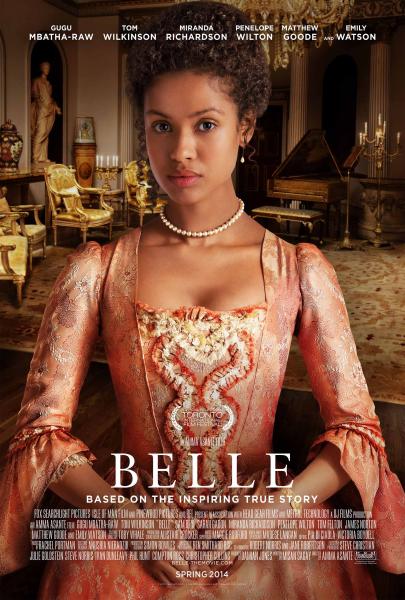
Recipe for a Delicious Movie: Belle
Looking for a great summer movie? Take one part Girl with the Pearl Earring, one part Amazing Grace (the Wilberforce movie); one part Pride and Prejudice; stir in terrific writing and acting; serve in a Downton Abby setting and you have Belle—a rich and moving story of love, legal drama, and the fight to eradicate the plague of slavery.
Movies don't usually move me to tears but…the painting below provided a clue to a powerful story…
Girl with the Pearl Earring:
Like the movie/book inspired by Jan Vermeer’s alluring painting, this movie too is inspired by a painting. When Misan Sagay, a young, black British doctor and screenwriter, first saw this double portrait of two young women hanging in Scone Palace in Scotland her jaw dropped,

Who is this beautiful dark-skinned young woman?
Unlike every other Victorian painting of blacks she had ever seen, there was no hint of subservience or deference to the white young woman. She is painted on eye level with her. She too wears a silk gown and a pearl necklace. She appears just as charming and intelligent…even more vivacious. And…the white girl affectionately touches her.
Unlike the fictional story behind Girl with the Pearl, when Sagay received permission to rummage through the boxes in the palace attic, she discovered an amazing true story behind the painting. It was not, as titled, “The Lady Elizabeth Murray and Dido, the Housekeeper’s Daughter.”
The fair Elizabeth and the bronzed Dido were cousins.
Dido Elizabeth Belle was the illegitimate daughter of Admiral Sir John Lindsay and an enslaved African woman, Maria Belle, whom he loved. They lived together for a while in the West Indies. The Admiral took young Dido, named for the famous black queen of Carthage, to England to live with her aristocratic great-uncle Lord Mansfield, the Lord Chief Justice, and his wife. There she grew up in the companionship of her cousin, Elizabeth, another great niece being raised by the Mansfields.
Sagay discovered in Lord Mansfield's legal notes that Dido served as his legal secretary. She also discovered a link between the two beauties and a somewhat forgotten story of a court case that advanced the movement to abolish slavery in the British Empire.
Amazing Grace: William Wilberforce and the Heroic Campaign to End Slavery
At the same time Dido was living in his home, assisting him in his work, Lord Chief Justice Mansfield had to decide a landmark court case concerning the slave ship Zong. The ship sailed from Africa with three times as many slaves as it should have for its size. Its captain was sick. It did not stop to replenish its supplies when it should have.
Ostensibly, in order to make it to Jamaica on dwindling provisions, the crew threw 54 women and children slaves through the cabin windows into the sea. Seventy-eight more slaves were thrown overboard within the next few days—all manicled and basically thrown to the sharks. The ship's owners claimed compensation from their insurers for the lost "human cargo." The insurers refused to pay and a lawsuit was filed. The movie unfolds the tension between the chief Justice’s love for his mulatto niece, his commitment to uphold the law, and the increasing evidence exposing the horrors and injustice of the legal slave trade.
The trade was so entrenched in the British economy that Lord Mansfield's verdict made little social or political impact. But it inspired the abolitionists. It also inspired another painting—Turner’s The Slave Ship. Manacled hands desperately reach up through the waves. A manacled single leg protrudes from a feeding frenzy of sharks while the slave ship recedes into an angry sky. Evangelical friends of William Wilberforce publicized the Zong massacre and other horrors of the slave trade (Prov 24:11-12). In 1789, six years after the Zong verdict, Wilberforce began parliamentary maneuvers to abolish the slave trade. In 1807 the law finally passed.
desperately reach up through the waves. A manacled single leg protrudes from a feeding frenzy of sharks while the slave ship recedes into an angry sky. Evangelical friends of William Wilberforce publicized the Zong massacre and other horrors of the slave trade (Prov 24:11-12). In 1789, six years after the Zong verdict, Wilberforce began parliamentary maneuvers to abolish the slave trade. In 1807 the law finally passed.
 desperately reach up through the waves. A manacled single leg protrudes from a feeding frenzy of sharks while the slave ship recedes into an angry sky. Evangelical friends of William Wilberforce publicized the Zong massacre and other horrors of the slave trade (Prov 24:11-12). In 1789, six years after the Zong verdict, Wilberforce began parliamentary maneuvers to abolish the slave trade. In 1807 the law finally passed.
desperately reach up through the waves. A manacled single leg protrudes from a feeding frenzy of sharks while the slave ship recedes into an angry sky. Evangelical friends of William Wilberforce publicized the Zong massacre and other horrors of the slave trade (Prov 24:11-12). In 1789, six years after the Zong verdict, Wilberforce began parliamentary maneuvers to abolish the slave trade. In 1807 the law finally passed.
Sagay wanted to write the story of Dido into the context of these real-life circumstances, but she wanted it to be primarily a love story. How does Dido discover her true worth? And how will she find a man who will love her for exactly who she is?
Pride and Prejudice:
As Jane Austen has shown us, typically women of the British aristocracy were valued for their bloodline, their title and their dowries. Also their beauty. Character and personality were often secondary. And falling in love mattered even less.
Because of her lineage the real Dido was loved and cared for as part of the family. But because of her color she was excluded from dining with the family when guests were present. Dido left no diaries so we don't know how she really thought and felt about her unique situation. But the movie's fictional conversations were patterned on diaries of women from the period.
In the movie, when they become old enough to marry, each girl has a handicap and an asset: Dido is an heiress and Elizabeth is penniless. Elizabeth is white. Dido is mulatto. Dido’s aristocratic suitor thinks he flatters her by telling her how much he admires her “better part." His brother makes it clear that her illegitimacy makes her fair game for his sexual advances.
In the most wrenching scene Dido sits at her vanity, gazing at her reflection. Slowly she begins to rub the back of her hands and pull at her throat– as if trying to peel off the color that stands between her and the life she longs for. She weeps in shame for who she is.
In the movie and in real life Dido meets John Davinier, portrayed in the movie as an idealistic young vicar’s son outraged by the injustice of slavery. In him Dido finds a champion who will be a voice for people with none. Gradually, Dido finds her own voice: “How can I be too high of rank to dine with the servants, but too low of rank to dine with my own family?” she asks her great-uncle.
Being loved for who she is and learning the truth of the injustices that have ravaged her people give Dido the courage to overcome her shame and carve out an identity built on the equal dignity of all humans made in God's image. Together she and John help shape the Lord Chief Justice's role to end slavery in England.
At age thirty-three the real Dido married a valet. They had two children. I hope she discovered her true worth, just as she did in the movie.
PS. So many movies are in tension with our faith. Thumbs way up for the redemptive and lovely Belle, newly released in both art house and popular theaters.
What are some other summer movies you recommend?



